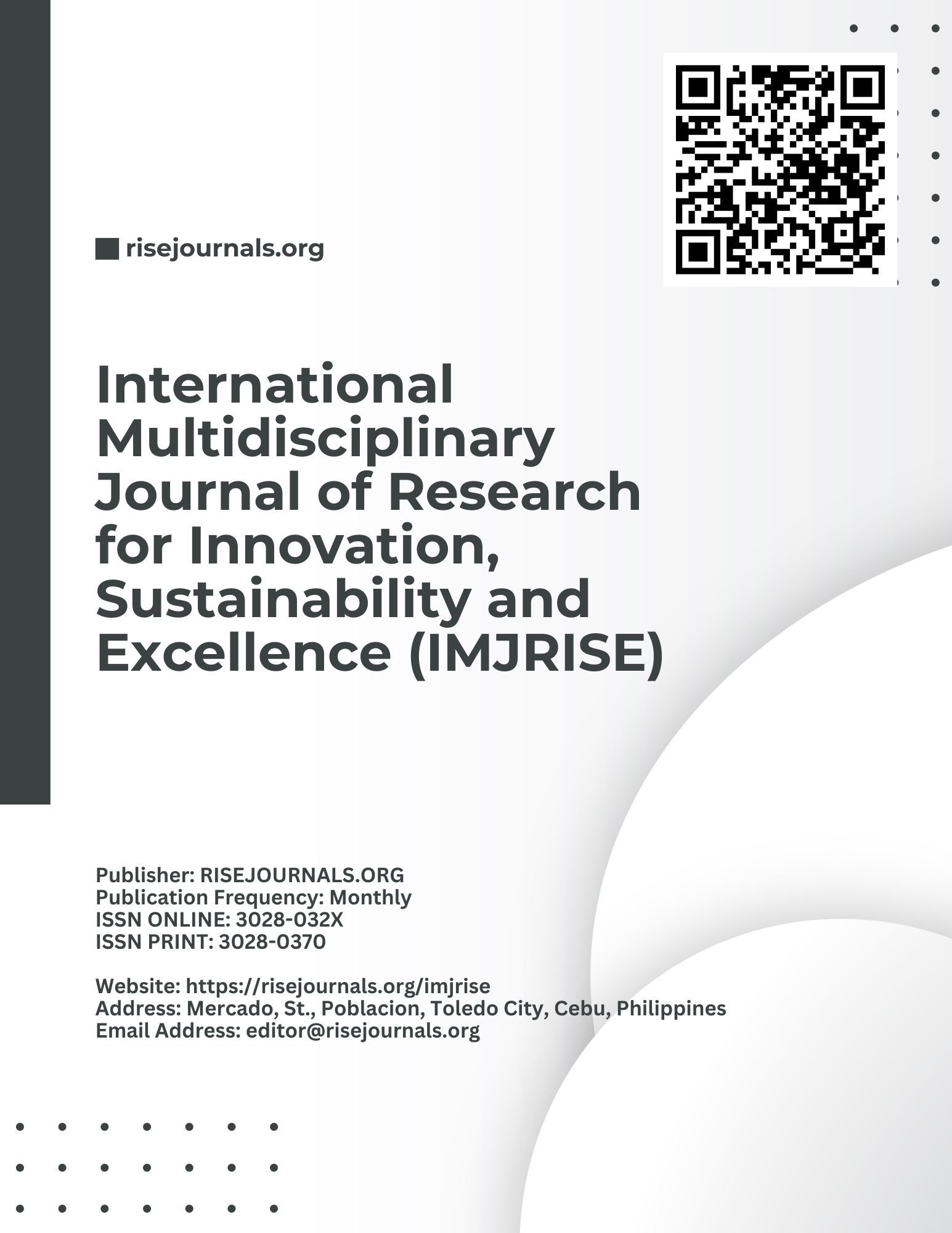Classroom to Workplace: Exploring the Role of Instructional Trainers in the EIM NC II Program
Keywords:
instructional trainers, technical vocational education, EIM NC II program, curriculum alignmentAbstract
This systematic review examines the development and acceptability of instructional trainers in technical vocational education, focusing on the Electrical Installation and Maintenance National Certificate Two (EIM NC II) program in the Philippines. Through a comprehensive analysis of existing literature, the study highlights the effectiveness of instructional trainers in enhancing learning outcomes and preparing students for real-world challenges in electrical installation and maintenance tasks. Additionally, the review emphasizes the importance of aligning instructional trainers with curriculum standards and competency requirements to ensure relevance and applicability in technical vocational education. Furthermore, user acceptability and satisfaction emerge as critical factors influencing the effectiveness and adoption of instructional trainers, with user-centered design principles and ongoing feedback mechanisms playing pivotal roles in shaping stakeholders' perceptions. Despite identified challenges, such as accessibility and scalability, opportunities for improvement, including the integration of technology-enhanced learning resources, are also discussed. Overall, the findings underscore the transformative potential of instructional trainers in technical vocational education and provide valuable insights for educators, policymakers, and researchers seeking to enhance the quality and effectiveness of vocational training programs.
References
Abulibdeh, A., Zaidan, E., & Abulibdeh, R. (2024). Navigating the confluence of artificial intelligence and education for sustainable development in the era of industry 4.0: Challenges, opportunities, and ethical dimensions. Journal of Cleaner Production, 140527.
Adhami, N., & Taghizadeh, M. (2022). Integrating inquiry-based learning and computer supported collaborative learning into flipped classroom: Effects on academic writing performance and perceptions of students of railway engineering. Computer Assisted Language Learning, 1-37.
Bixby, D. W. (2018). Product training for the technical expert: The art of developing and delivering hands-on learning. John Wiley & Sons.
Brown, A. H., & Green, T. D. (2019). The essentials of instructional design: Connecting fundamental principles with process and practice. Routledge.
Chaudhary, N., Patel, V., & Vidani, C. J. (2023). A Review of Non-Technical Training Programmes Conducted by Corporate Trainers for IT Companies. Internafional Journal of Management Analyfics, 85-110.
Diano Jr, F., Kilag, O. K., Malbas, M., Catacutan, A., Tiongzon, B., & Abendan, C. F. (2023). Towards Global Competence: Innovations in the Philippine Curriculum for Addressing International Challenges. Excellencia: International Multi-disciplinary Journal of Education (2994-9521), 1(4), 295-307.
Doerner, R., & Horst, R. (2022). Overcoming challenges when teaching hands-on courses about Virtual Reality and Augmented Reality: Methods, techniques and best practice. Graphics and Visual Computing, 6, 200037.
Doyle, T., & McDonald, C. (2022). Integration of Core First Year Engineering Courses into Sequenced Experiential Learning: The Integrated Cornerstone. Proceedings of the Canadian Engineering Education Association (CEEA).
Echols, D. G., Neely, P. W., & Dusick, D. (2018). Understanding faculty training in competency‐based curriculum development. The Journal of Competency‐Based Education, 3(2), e01162.
Fuentes, M. A., Zelaya, D. G., & Madsen, J. W. (2021). Rethinking the course syllabus: Considerations for promoting equity, diversity, and inclusion. Teaching of Psychology, 48(1), 69-79.
GOVPH. (n.d.). K to 12 Basic Education Program. https://www.officialgazette.gov.ph/k-12-old/
Hmelo-Silver, C. E., Duncan, R. G., & Chinn, C. A. (2007). Scaffolding and achievement in problem-based and inquiry learning: a response to Kirschner, Sweller, and. Educational psychologist, 42(2), 99-107.
Jayeola, O., Sidek, S., Rahman, A. A., Bali Mahomed, A. S., & Jimin, H. (2020). Contextual factors and strategic consequences of cloud enterprise resource planning (ERP) adoption in Malaysian manufacturing SMEs: A conceptual framework.
Kilag, O. K., Miñoza, J., Comighud, E., Amontos, C., Damos, M., & Abendan, C. F. (2023). Empowering Teachers: Integrating Technology into Livelihood Education for a Digital Future. Excellencia: International Multi-disciplinary Journal of Education (2994-9521), 1(1), 30-41.
Laurillard, D., Oliver, M., Wasson, B., & Hoppe, U. (2009). Implementing technology-enhanced learning. Technology-enhanced learning: Principles and products, 289-306.
Malbas, M., Kilag, O. K., Diano Jr, F., Tiongzon, B., Catacutan, A., & Abendan, C. F. (2023). In Retrospect and Prospect: An Analysis of the Philippine Educational System and the Impact of K-12 Implementation. Excellencia: International Multi-disciplinary Journal of Education (2994-9521), 1(4), 283-294.
Marope, P. T. M., Chakroun, B., & Holmes, K. P. (2015). Unleashing the potential: Transforming technical and vocational education and training. UNESCO Publishing.
Manire, E., Kilag, O. K., Habig, M., Satin, R., Genovania, M. R., & Tan, S. J. (2023). A Technological Approach to Early Childhood Education: Unveiling the SEEDS Pedagogy. Excellencia: International Multi-disciplinary Journal of Education (2994-9521), 1(5), 333-344.
Martinez, N., Kilag, O. K., & Macario, R. (2023). The Impact of Organizational Culture on Leadership Strategies in Crisis Management. Excellencia: International Multi-disciplinary Journal of Education (2994-9521), 1(5), 454-466.
Rauniar, R., Rawski, G., Yang, J., & Johnson, B. (2014). Technology acceptance model (TAM) and social media usage: an empirical study on Facebook. Journal of enterprise information management, 27(1), 6-30.
SEAMEO INNOTECH. (2014). K-12 in Southeast Asia. https://www.seameo-innotech.org/portfolio_page/k-to-12-in-southeast-asia/
Tahir, R., & Abdullah, Z. (2023). Revolutionising Delivery in TVET for Industry 4.0: Strategies from the Field–NGT and ISM Approach. Journal of Current Science and Research Review, 1(05), 139-157.
TESDA. (2015). Amended Training Regulations for Electrical Installation and Maintenance National Certificate II. https://tesda.gov.ph/Downloadables/TR-Electrical%20Installation%20and%20Maintenance%20NC%20II.pdf
TESDA Policy Brief. (2013). Technical Education and Skills Development Authority. https://www.tesda.gov.ph/uploads/File/policybrief2013/PB%20Kto12%20as%20of%20Sept.20,%202013.pdf
Tondeur, J., Van Braak, J., Sang, G., Voogt, J., Fisser, P., & Ottenbreit-Leftwich, A. (2012). Preparing pre-service teachers to integrate technology in education: A synthesis of qualitative evidence. Computers & education, 59(1), 134-144.
United Nations. (2018). Goal 4: Quality Education. https://www.un.org/sustainabledevelopment/education/
Uy, F., Kilag, O. K., Abendan, C. F., Macapobre, K., Cañizares, M. C., & Yray, F. (2023). Application of Adaptive Crisis Management Theory: The Dynamics of Leadership in Times of Crisis. Excellencia: International Multi-disciplinary Journal of Education (2994-9521), 1(5), 159-170.
Zhang, Y., Chen, L., Yang, S., Yuan, M., Yi, H., Zhang, J., ... & Zheng, B. (2022, May). PICASSO: Unleashing the Potential of GPU-centric Training for Wide-and-deep Recommender Systems. In 2022 IEEE 38th International Conference on Data Engineering (ICDE) (pp. 3453-3466). IEEE.


